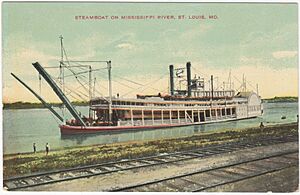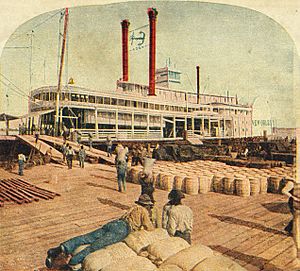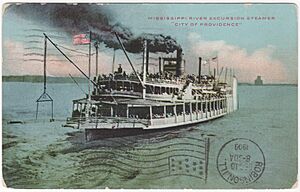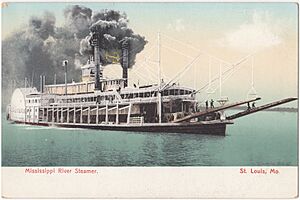Anchor Line (riverboat company) facts for kids
The Anchor Line was a well-known steamboat company. It operated many boats on the Mississippi River. These boats traveled between St. Louis, Missouri, and New Orleans, Louisiana. The company ran from 1859 until 1898. It was one of the most famous steamboat groups on the lower Mississippi River after the American Civil War.
Contents
History of the Anchor Line
Early Years: 1859-1879
The company started in 1859. It was first called the Memphis and St. Louis Packet Line. It mainly served Memphis and St. Louis. Two years later, the American Civil War began. Many steamboat owners had to stop their businesses. But the Memphis and St. Louis Packet Line kept going. They operated on parts of the Mississippi River controlled by Union forces.
By 1862, the Union controlled the river as far south as Memphis. A year later, most river ports were under Union control. Only Vicksburg, Mississippi, and Port Hudson, Louisiana, were still held by the Confederates. On July 4, 1863, Union forces took Vicksburg. The next day, Port Hudson surrendered. This opened the entire river for steamboat traffic again.
In 1874, the company started using a giant anchor as its symbol. This is likely when they changed their name to the "Anchor Line." The anchor symbol was placed between the two tall smokestacks on each boat. It was also on the furniture inside the boats.
The Golden Era: 1880-1894
By the early 1880s, the company had enough money. They decided to build many new steamboats. Most of these boats were built by the Howard Shipbuilding Company. The Anchor Line spent a lot of money on these boats. They became like floating palaces of the late Victorian era.
Between 1880 and 1887, the Anchor Line built ten of these fancy steamboats. They were about 275 feet (83.33 m) long. They were also about 45 feet (13.64 m) wide. Most steamboats were named after people or nice ideas. But the Anchor Line named their boats after cities along their route. The first of these was the Belle Memphis. When it arrived in Memphis in 1881, the city gave it a gift of flags.
Most of these boats avoided common river disasters. These included fires, snags (underwater logs), ice, and getting stuck on sandbars. They stayed in service until the company closed in 1898. One boat, the City of Providence, was built in 1880. It was sold when the Anchor Line closed. It was used by other companies until ice destroyed it in 1910. That was 29 years after it first started running!
Decline and Collapse: 1894-1898

River Challenges
The Mississippi River was often difficult for boats. High water could cover landings. This made it hard for steamboats to stop at smaller towns. Low water could leave towns far from the river. It also increased the risk of snags damaging boats. Floods, like the big one in 1892, could destroy crops. This meant less cargo for the steamboats to carry. The early 1890s, especially 1892 and 1894, were tough years for the Anchor Line because of river conditions.
Railroad Competition
Another big problem was the growing railroad network. Trains started competing directly with steamboats. They carried both passengers and cargo. Train tracks could be built almost anywhere. This meant trains could reach more towns than any steamboat. Trains were also generally safer. They were not affected by snags, sandbars, or ice. Plus, trains were faster. They traveled much quicker than the 15 mph (24.3 km/h) of Anchor Line boats.
The 1896 Tornado
Historians believe a terrible tornado in 1896 sealed the Anchor Line's fate. On May 27, the tornado hit St. Louis. It swept across the river into East St. Louis, Illinois. About 255 people died. The Anchor Line's fancy steamboats were docked in St. Louis. They were right in the tornado's path. The Arkansas City and the City of Cairo were completely destroyed. The City of Monroe was badly damaged.
Later that year, the company launched another boat, the Bluff City. In 1897, the Anchor Line fixed the City of Monroe. They made it longer and added electric lights. They renamed it the Hill City. The company even printed a brochure to attract passengers. But that same year, the Bluff City was destroyed by fire. The Belle Memphis was badly damaged by a snag. And the City of Hickman sank.
These disasters were too expensive for the Anchor Line. In 1898, they sold their remaining boats and stopped operating.
Anchor Line Routes
The Anchor Line served most major cities between St. Louis and New Orleans. They also stopped at many smaller landings if needed. Not all boats traveled the entire route regularly. For example, the Arkansas City mostly worked between St. Louis and Natchez from 1888 to 1896.
Main stops included:
- Cairo, Illinois
- New Madrid, Missouri
- Hickman, Kentucky
- Memphis
- Helena, Arkansas
- Greenville, Mississippi
- Vicksburg
- Natchez, Mississippi (and Vidalia, Louisiana, across the river)
- Bayou Sara, Louisiana
- Baton Rouge, Louisiana
- Donaldsonville, Louisiana
- New Orleans
Anchor Line Boats
Starting in 1880, most new Anchor Line boats were side-wheelers. This means they had two large paddlewheels. These wheels were on the sides of the boat, about two-thirds of the way back. The only exception was the Bluff City, which had a wheel at the back.
| Boat Name | Year Built | Interesting Facts |
| Belle Memphis (I) | 1866 | This side-wheeler was about 260 feet (79 m) long. It usually traveled between St. Louis and Memphis. It was taken apart in 1880. Its engines were likely used for the second Belle Memphis. |
| James Howard | 1870 | A very large boat, about 320 feet (98 m) long. It cost $180,000 to build. About 45,000 people visited it in Cincinnati in 1871. The Anchor Line bought it in 1878. It burned in St. Louis in 1881, but everyone escaped safely. |
| City of Vicksburg (I) | 1870 | This side-wheeler was commanded by Captain Robert Riley. It sank on a snag (underwater log) in 1880 while carrying a lot of cargo. |
| Grand Tower | 1871 | This boat was mentioned in a court case from 1873. It had been in service for two years at that time. |
| Belle Memphis (II) | 1880 | This boat was 267 feet (81 m) long. Its engines were probably from the first Belle Memphis. It received a piano and flags from the city of Memphis in 1881. Its pilot around 1895 was Horace Bixby, who is famous from Mark Twain's books. It was badly damaged by a snag in 1897. |
| City of Providence | 1880 | This was the Anchor Line boat that lasted the longest. It was destroyed by ice in 1910, 12 years after the Anchor Line sold it. |
| City of Vicksburg (II) | 1881 | This boat was a typical size for Anchor Line boats. It was sold in 1894. It was damaged in the 1896 St. Louis tornado. It was later rebuilt and sank in 1904. |
| City of Cairo | 1881 | This boat worked for the Anchor Line for 15 years. It was destroyed by the 1896 tornado. |
| City of Baton Rouge | 1881 | This boat was 294 feet (90 m) long. It got stuck on rocks near Louisville when it was first delivered. It operated between St. Louis and New Orleans. It sank in 1890, and two passengers were lost. |
| City of New Orleans | 1881 | This boat was 290 feet (88 m) long. Its captain from 1885 to 1891 was A.J. Carter. In 1898, it was taken apart, and its parts were used for another boat. |
| Arkansas City | 1882 | This boat worked for the Anchor Line for 14 years. It mostly traveled between St. Louis and Natchez. It was destroyed in the 1896 St. Louis tornado and never fixed. |
| Will S. Hayes | 1882 | This boat was sold to the Anchor Line sometime after 1882. Some sources say it was built for the Anchor Line. |
| City of St. Louis | 1883 | This boat was 300 feet (91 m) long. In 1894, Captain James O'Neal commanded it. It was sold in 1898 for $19,050. U.S. President William McKinley rode on this boat in 1901. It burned in 1903. |
| City of Bayou Sara | 1884 | This was a larger-than-average Anchor Line boat, about 300 feet (91 m) long. It burned in 1885 while loading corn. Eight people died in the fire. |
| City of Natchez | 1885 | This boat was 300 feet (91 m) long. Horace Bixby was its captain. It was called the "brag boat of the Anchor Line." It was lost to a fire in 1886 that started on a nearby boat. |
| City of Monroe | 1887 | Named after Monroe, Louisiana. It was a popular boat. It was damaged in the 1896 St. Louis tornado. It was rebuilt, made longer, and renamed Hill City. It was sold in 1898. It sank in 1900 but was raised. It was renamed Corwin H. Spencer and carried passengers at the St. Louis World's Fair in 1904. It was destroyed by fire in 1905. |
| City of Hickman | 1894? | This boat sank in 1896. |
| Bluff City | 1896 | This was the only stern-wheeler (paddlewheel at the back) built by the Anchor Line. It burned a year after it was built. |






